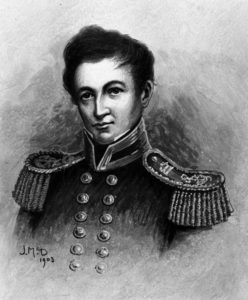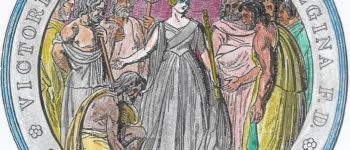1841: The Colony of New Zealand
May 3, 2021
By AHNZ

Today in history, 3 May, is New Zealand’s 180th birthday. I doubt anybody else will be writing about it but this is the day in 1841 we became the Colony of New Zealand rather than a sub-unit of the Colony of New South Wales.
Governorship of New Zealand came into being, rather than Governorship over New Zealand. Power passed from Governor George Gipps (annexed New Zealand in January 1840) to his Lieutenant-Governor William Hobson who now became rank-equal as Governor himself.
 Hobson’s new title came with accessories such as new epaulettes and, I suppose, a cooler hat. The new Commander and Chief of New Zealand also became first holder of The Great Seal of New Zealand (image left.)
Hobson’s new title came with accessories such as new epaulettes and, I suppose, a cooler hat. The new Commander and Chief of New Zealand also became first holder of The Great Seal of New Zealand (image left.)
 There were also ramifications for New Zealand’s map. The Charter of 1840 stipulated that the world’s newest colony would be divided into New Ulster, New Munster, and New Leinster (North Island, South Island, Stewart Island.) Why the Colonial Office felt the need to brand us with the names of Irish provinces except perhaps that they wanted all the British Isles to get the treatment the Dutch gave to Zeeland. Scotland had already spawned New Caledonia and Nova Scotia, Wales dubbed at New South Wales. England itself, and York too, were New versions of themselves in America. So, it was the turn of Ireland to be included and 3/4 provinces (nothing for Connacht) were given the New World names treatment.
There were also ramifications for New Zealand’s map. The Charter of 1840 stipulated that the world’s newest colony would be divided into New Ulster, New Munster, and New Leinster (North Island, South Island, Stewart Island.) Why the Colonial Office felt the need to brand us with the names of Irish provinces except perhaps that they wanted all the British Isles to get the treatment the Dutch gave to Zeeland. Scotland had already spawned New Caledonia and Nova Scotia, Wales dubbed at New South Wales. England itself, and York too, were New versions of themselves in America. So, it was the turn of Ireland to be included and 3/4 provinces (nothing for Connacht) were given the New World names treatment.
As a matter of interest, The Charter of 1840 specified the equivalent coordinates for New Zealand in the northern hemisphere of the world. This was a cut’n paste of Hobson’s own hasty Hobson’s Proclamation of Sovereignty (21 May 1840) over all New Zealand¹. It was later moved but for a time the Colony of New Zealand was, legally speaking, located in North Pacific empty water about 3000km off the east coast of Japan.
“No explanation was given as to why the names of Irish provinces were being applied to a country on the other side of the world, though the north and south dispositions of the regions coincided.” – The Penguin History of NZ, King (2003)
“…Imperial Parliament passed an Act authorising The Crown, by Letters Patent, “to erect into a separate Colony or Colonies any Islands which now are or which hereafter may be comprised within and Dependencies of the said Colony of New South Wales”. This important step was taken..commonly known as the Charter of 1840, New was raised to the dignity of a separate colony.” – McLintock (1958)
Hobson threw in the Chatham Islands by another proclamation in 1842.
The Great Seal of New Zealand, 1841-1848
 When Governorship of New Zealand passed to William Hobson it came with this special seal made by the Queen’s engraver. Probably made of silver, it’s a national treasure and a symbol of The State. After it expired, the seal was replaced by others depending on the times and who the sovereign was. Sort of like updating the desktop background image on your computer.
When Governorship of New Zealand passed to William Hobson it came with this special seal made by the Queen’s engraver. Probably made of silver, it’s a national treasure and a symbol of The State. After it expired, the seal was replaced by others depending on the times and who the sovereign was. Sort of like updating the desktop background image on your computer.
This one, the first one, says ‘Queen Victoria, DG (empowered by God,) British Queen, FD (defender of the faith) Seal of New Zealand.’ Victoria Regina is depicted as being central to a group of 8 tribal chiefs deferring to her Majesty.
I wonder what the seal looked like that Lieutenant-Governor Hobson used previously? Its mark ought to be on the Treaty of Waitangi but I think it’s smashed up so we can’t tell. New Zealand was an independent nation from 1835 and recognised as such by Victoria’s predecessor, William IV, with its own flag; Did they have a seal? If so, you wont read about it in State History books!
The Colony of New Zealand
 So today is our 180th anniversary. It’s not a day remembered or remarked upon, at least not these days. Government history would be embarrassed to tell the truth about how New Zealand really came to be governed by Hobson and his Gang. Until 3 May 1841 Captain Hobson wasn’t Lieutenant-Governor of anything but had been fudging along until these Letter Patent squared things away. His initial brief was to be Lieutenant-Governor over any parts of New Zealand ‘which is or may be acquired in sovereignty’. Hobson didn’t bother acquiring anything. Even before the Treaty of Waitangi (which wasn’t even legal but that was never the point..) Hobson had proclaimed himself Lt. Governor by the power of…his saying so.
So today is our 180th anniversary. It’s not a day remembered or remarked upon, at least not these days. Government history would be embarrassed to tell the truth about how New Zealand really came to be governed by Hobson and his Gang. Until 3 May 1841 Captain Hobson wasn’t Lieutenant-Governor of anything but had been fudging along until these Letter Patent squared things away. His initial brief was to be Lieutenant-Governor over any parts of New Zealand ‘which is or may be acquired in sovereignty’. Hobson didn’t bother acquiring anything. Even before the Treaty of Waitangi (which wasn’t even legal but that was never the point..) Hobson had proclaimed himself Lt. Governor by the power of…his saying so.
“On arriving at the Bay of Islands, however, and before negotiations at Waitangi, he declared himself Lieutenant-Governor….his procedure was anomalous, for he had proclaimed himself Lieutenant-Governor of a British colony that did not, as yet, exist.”- p72 Sinclair (1959)
Only after the fact did the ‘Lt. Governor’ seek a Treaty, circulate it for signatures, demand the Wellington Settlers tow the line, and proclaim the South Island his by right of discovery. This was all a crazy mess and the settlers furious. But Hobson had the support he needed back in Britain to fix all his mistakes and make all his lies true, legally speaking. Someone who liked giving Irish provincial names to things. Probably someone who was a mutual friend of Lord Auckland, Hobson’s mentor.
If I want to read more about that I’ll have to write it. It will not be recorded in Statist history, only Anarchist history which is written between the lines and largely ignored. There are not New Zealand on Air or Lotto Grants for uncovering this information!
—
Ref. Crown Colony Government in New Zealand, McLintock (1958)
Ref. A History of New Zealand, Sinclair (1959)
1 Ref. p99 McLintock (1958)
Image ref. Great Seal 1841; Colourised by AHNZ (2020)
Ref. 1840: Who Was Our First Governor? The Answer May Startle You…; AHNZ
 Like Comment Share
Like Comment Share





